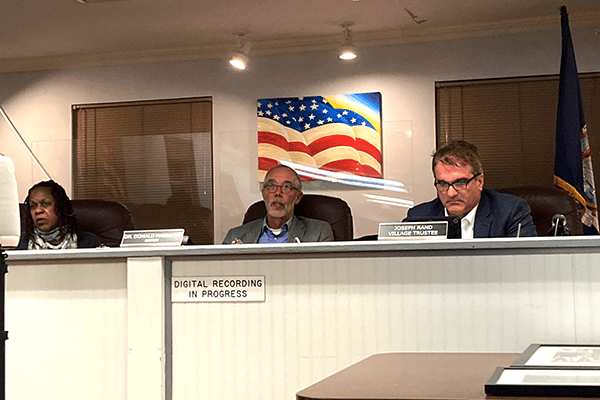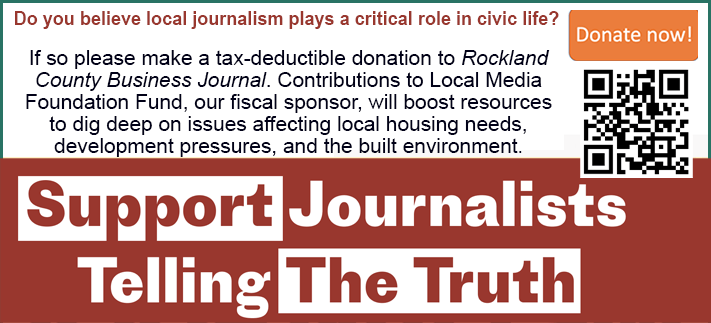|
RCBJ-Audible (Listen For Free)
|
Apartment Buildings Constructed Before 1974 Containing 25 Or More Units Subject To Rent Stabilization In Nyack; Village Board Creates A Mechanism For Landlords To Opt-Out
REAL ESTATE
After a year of deliberation — infused with dueling testimony from landlords and renters in the one-square-mile Village of Nyack — the village trustees adopted a law that will cap rent increases in apartment buildings constructed before 1974 that contain 25 or more units.
The Board of Trustees voted unanimously last Thursday to adopt rent stabilization measures under New York’s Emergency Tenant Protection Act.
There is nearly universal agreement that there is an affordable housing crisis in Nyack and in Rockland County at large.
“We are losing part of our community,” said the outgoing mayor Don Hammond, who did not run for re-election. “I have a passion for this community, That’s what led me to this. We need to manage rent increases and this is the only instrument we had. We are not able to pass our own rent control laws.”
Renters throughout the year have returned to Village meetings to speak about untenable rent increases — sometimes as high as 50 percent — as well as deteriorating conditions in their buildings. At the same time, landlords have given testimony over the rising costs of maintaining buildings.
Christina Farrell, a renter, said in 2015 her rent was $1,000. When the building was purchased, rents rose year over year from $1,165 to today’s rent of $2,495.
Alexander Bursztein of the Legal Aid Society of Rockland County Inc. said the rental situation has never been worse.
“Landlords raise the rent 50 percent because they can,” said Bursztein. “You don’t want to have a community of only the rich. You want diversity, a mix. ETPA works. It limits rents. It requires 90-day notices for eviction. This will stop the unfettered discretion.”
New York’s Emergency Tenant Protection Act (ETPA), which is part of the Housing Stability and Tenant Protection Act of 2019 allows any municipal government in New York State to declare a housing emergency when a specified class of buildings has a vacancy rate of less than 5 percent. In this instance, to avoid burdening smaller mom-and-pop and noon-institutional landlords, Nyack chose only buildings with 25 or more units.
There is nearly universal agreement that there is an affordable housing crisis in Nyack and in Rockland County at large.
“For the last five years I’ve heard anecdotes about rents in Nyack going up,” said Joe Rand, mayor-elect. The data suggests we really do have a rent emergency, the market is under stress and that needs relief. This is not normal.”
In October, the Village Board accepted a rent survey, over landlord objections, indicating that vacancy rates in affected building were less than 5 percent — the threshold in New York State to enact stabilization. The survey, prepared by Village Administrator Andy Stewart, encompassed nine buildings with more than 900 apartments that collectively reported a vacancy rate of 4.55 percent.
Rand also tracked rents over a five-year period from data based on the local Multiple Listing Service. Rand concluded, that the average rental price is 32.7 percent higher than it was in 2019; the average price-per-square-foot is 39.5 percent higher than it was in 2019, and that the average rental unit rents for 3.6 percent more than the listing price – indicative of a bidding was on existing rentals. Rand’s data is available at: rand.me/ETPA.
But landlords affected by the decision, as well as representatives from trade groups, pushed back on the proposal.
“I have sympathy with the issue but ETPA only makes things worse,” said Timothy Foley, CEO and Executive Vice President of The Building & Realty Institute. “The act was passed in 1974. This was a 20th century solution. It will mean that 20 percent would be covered; you need protection for 80 percent. There will be disinvestment in those properties.”
The ETPA imposes various restrictions on apartments under its umbrella, including having a rent control board determine annual rent increases, requiring minimal levels of building maintenance, and allowing tenants to file complaints of abuses. Tenants would also be entitled to lease renewals at fixed rental adjustments. The ETPA limits a landlord’s ability to raise rents even when a unit becomes vacant and limits a landlord’s ability to recoup investments in improvements to the building and individual units through increased rent.
At the public hearing, several landlords and landlord association representatives opposed passage and said that the ETPA would create a disincentive for landlords to maintain and repair buildings and to upgrade and modernize individual apartment units. They referred to the ETPA as a “blunt instrument” that unfairly penalizes landlords for societal housing shortages they did not create.
To accommodate objections, the Village provided exemptions for:
(1) any buildings that are completely and entirely comprised of apartments subject to the Section 8 Housing Choice Voucher program through the U.S. Department of Housing and Urban Development (i.e., 100% Section 8 apartments); or
(2) buildings whose owners that “have duly entered into a legally binding and enforceable agreement or contract with the Village, which shall run with the land, and which agreement or contract addresses, by ameliorative means, the Village’s local housing emergency in a manner that is satisfactory to the Board.”
It was not clear what these “agreement or contracts” would include, but the exemption was a by-product of discussions with landlords and their attorney and their efforts to negotiate relief from the rigid structure of the ETPA.
The City of Newburgh recently completed a study of rental units and found that Newburgh’s vacancy rate is just shy of 4 percent, clearing the first hurdle toward adopting rent stabilization on certain qualifying units under the state Emergency Tenant Protection Act. In Newburgh, about 738 units would be affected.
In July of 2022, the City of Kingston declared a housing emergency, based on its study of local housing conditions and vacancies. Kingston was the first upstate municipality to opt into the Emergency Tenant Protection Act (ETPA).
Earlier this year, Croton on Hudson opted to expand the Emergency Tenant Protection Act in the Village to include all properties with six or more units which were built prior to 1974. Previously, only buildings with 50 or more units were covered by its ETPA regulations.
Efforts to undermine New York’s rent stabilization law were recently rejected by the United States Supreme Court when it declined to consider a challenge by landlords and owners that sought to have the rent stabilization laws declared unconstitutional. The arguments made to the high court charged that rent stabilization laws deprive owners of their property rights, specifically their rights “to exclude, occupy, use, change the use of, and dispose of their property.”














